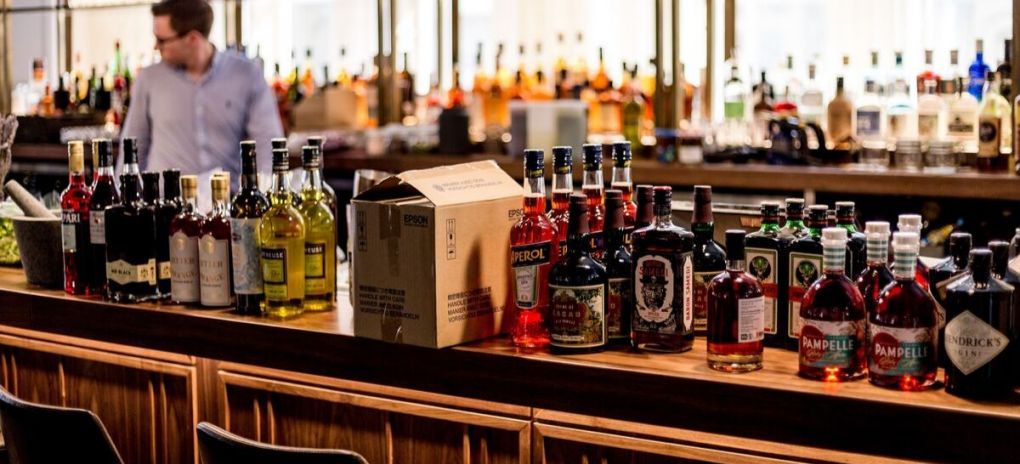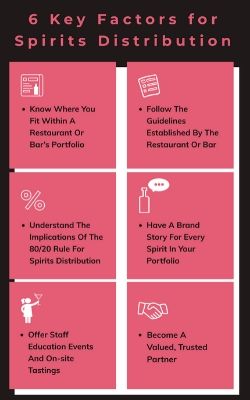
05/07/2019 360-degree view of the distribution process, its strength, weaknesses, and opportunities and threats in the marketplace.
In order to maximize the distribution of your spirits brand in restaurants and bars, there are a number of important points to keep in mind. In today’s hyper-competitive spirits industry, it is no longer enough just to offer a high-quality product at a competitive price. You need to take a full, 360-degree view of the distribution process and understand the strengths, weaknesses, opportunities and threats in the marketplace.
Let's Connect On LinkedIn
Know where you fit within a restaurant or bar’s portfolio
The starting point for coming up with an effective distribution strategy is taking a portfolio approach. Just as you might have a portfolio of different spirits that you are trying to sell to a restaurant or bar, that same restaurant or bar also has a portfolio of spirits that they are updating on a regular basis. The key here is to find the perfect match between your spirit brand and the brand of the restaurant or bar. For example, it could be the case that the bar is trying to establish a reputation for offering the most comprehensive selection of gins in the local area. If that’s the case, you can forget about trying to sell spirits like bourbon or vodka; instead, focus on all the artisanal and craft-distilled gins in your portfolio and why they would make a perfect match for this bar.
Follow the guidelines established by the restaurant or bar
Every restaurant has its own cycle and timing for rotating the various spirits in its inventory. It could be the case that a restaurant rotates its wine inventory every quarter, but its spirits inventory only every six months. That’s good information to know since you will need to reorganize your distribution strategy around this schedule and timing. And, at a more granular level, it could be the case that restaurants or bars have set up very specific “windows” when you can call on them. It could be the case that the beverage director is only available to talk with sales reps on certain mornings, or that all meetings need to be held to under 30 minutes. All of these guidelines, no matter how idiosyncratic they might appear, need to be followed. It’s all part of establishing a mutual relationship based on trust and respect.

Understand the implications of the 80/20 rule for spirits distribution
The 80/20 rule, as applied to spirits distribution in bars and restaurants, suggests that 80& of your sales will come from just 20% of your accounts. That’s actually a very profound statement, if you consider the amount of time that your sales reps are spending in an effort to get your product into restaurants and bars. It suggests that 80% of your efforts should be spent on just a few VIP accounts that have the greatest potential to move the needle when it comes to sales. Put another way, lining up a series of very small distribution deals at a large number of establishments is not going to be as effective in the long run as lining up a series of very large distribution deals at a small number of establishments.
Have a brand story for every spirit in your portfolio
Today, spirits are brands, much like any other fast-moving consumer goods. That’s because many people drink a particular spirit not for the taste, but because of what the brand says about them as an individual. It’s the reason why a premium tequila brand like Casamigos, launched by Hollywood celebrity George Clooney, is now worth more than $1 billion. Drinking this premium tequila says a lot about your lifestyle and what you want others to think about you.
With that in mind, you need to develop a brand story for every single spirit that you are trying to get distribution for in restaurants and bars. That is why, in large part, craft-distilled spirits are so popular right now. In contrast to the big national or multinational spirits brands, these craft spirits come with a unique artisanal focus. In some cases, these spirits have established a compelling narrative that links them to the pre-Prohibition era in America, giving them a unique type of credibility with spirits drinkers. For example, think about the phenomenal success of rye whiskey in recent years. In Pennsylvania, craft distillers have linked rye whiskey to the pre-Prohibition era in America. And that makes these whiskies much easier to sell into establishments like modern-day speakeasies, which are also invoking the glamour and history of a period nearly 100 years ago in American history.
Offer staff education events and on-site tastings
The more that restaurant or bar staff members know about your spirits, the more likely they are to recommend them to patrons. That’s true also for bartenders and mixologists – they are going to be much comfortable recommending your spirit (or a cocktail made with your spirit) if they know as much as possible about how it is made and how it tastes. Thus, there will always be an extra advantage for spirits brands that are able to provide a little after-sale support in the form of education, training and tastings.
Become a valued, trusted partner
Finally, think about ways that you can transform a relationship from a purely transactional one (in which you provide a specific spirit at a specific price on a specific date) into a more strategic one. As noted above, education, training and tastings fit into this idea of a strategic relationship. And there are many other extras that you can deliver, all in an effort to have restaurants and bars view you as a trusted, valued partner and not just as a vendor. In some cases, that might mean providing support in merchandising your spirits within a specific bar or restaurant. In other cases, it might mean providing speciality glassware for enjoying your spirit in the way it was meant to be enjoyed.
When thinking about spirits distribution in on-premise establishments such as restaurants and bars, take a big picture view. Start by understanding what makes a good match between a spirits brand and a restaurant or bar, and then follow up in a way that shows you are thinking about each new client not as a transaction, but as a partnership or relationship.



